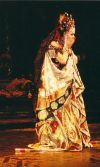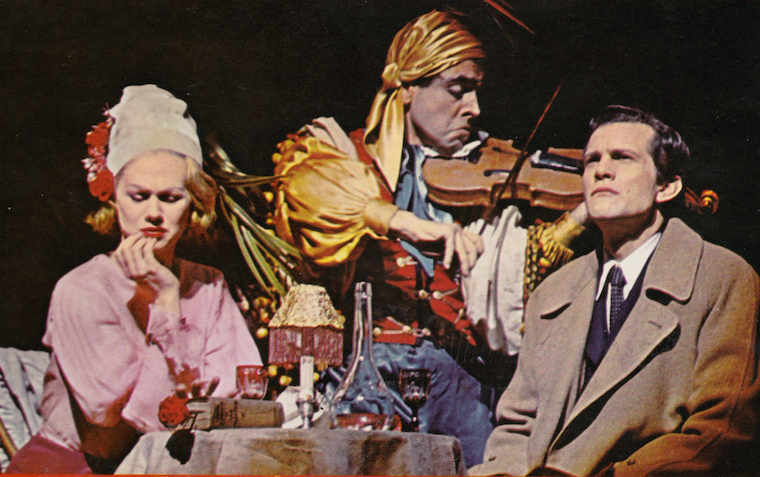The Princess Musicals
#1The Princess Musicals
Posted: 4/16/15 at 10:55am
Can someone explain to me what the Princess Musicals were? Weren't they big expensive shows at the time??
aj88
Featured Actor Joined: 3/18/15
#2The Princess Musicals
Posted: 4/16/15 at 11:07am
The Princess Theatre was a very small Broadway house that was on W 39th St near 6th Ave. I think it only sat around 250-300 people.
I don't remember if they were spectacle shows for the time but I know that a lot of "important" musicals for the era opened there like Very Good Eddie and Oh Kay.
#2The Princess Musicals
Posted: 4/16/15 at 11:08am
Google is your friend.http://broadwayscene.com/broadway-history-the-princess-musicals-bigger-was-not-better/
#3The Princess Musicals
Posted: 4/16/15 at 11:22am
Thank you for that link!! Ive been researching stuff, and can't find how much they cost. Anyone know?
#4The Princess Musicals
Posted: 4/16/15 at 11:29am
The Princess musicals were by Kern and Wodehouse. Oh, Kay! was writen by the Gershwins. Perhaps you are thinking of Oh Boy? I don't think the budgets for musicals were revealed at the time (1915 onwards). You should listen to the score of Very Good Eddie. There was a revival in the 1970's and they made a cast album that was just wonderful.
aj88
Featured Actor Joined: 3/18/15
#5The Princess Musicals
Posted: 4/16/15 at 11:31am
"The Princess musicals were by Kern and Wodehouse. Oh, Kay! was writen by the Gershwins. Perhaps you are thinking of Oh Boy? I don't think the budgets for musicals were revealed at the time (1915 onwards). You should listen to the score of Very Good Eddie. There was a revival in the 1970's and they made a cast album that was just wonderful."
Good call! Thanks for correcting me. I remember it had the Kern/Wodehouse connection but wasn't thinking.
#6The Princess Musicals
Posted: 4/16/15 at 11:33am
Here's a great reference from musicals 101:
Jerome Kern: "They Didn't Believe Me"
The American musical found a new creative direction thanks to Jerome Kern, a native New Yorker who got his start amending the scores of imported British musicals. Since British high society rarely arrived at a theatre before intermission, London musicals of the early 1900s often saved their best material for the second act and filled their early scenes with forgettable fluff. These shows had to be revised for New York audiences, who tended to arrive for the first curtain and leave at intermission if the first act was not up to snuff.
When producer Charles Frohman brought over the British hit The Girl From Utah (1914 - 120), the plot (an American girl flees to London rather than become a rich Mormon's latest wife) proved amusing, but the British score was unremarkable. So Frohman hired Kern and veteran lyricist Herbert Reynolds to write five new numbers for the lackluster first act.
Julia Sanderson and Donald BrianWhen Julia Sanderson and Donald Brian introduced Kern's "They Didn't Believe Me" in The Girl From Utah, they became one of the most popular stage duo's of their time. These photos come from the original cast program.
Kern and Reynolds had added songs to previous imports. This time they demanded and got full program credit. Their delightful ballad "They Didn't Believe Me" marked a turning point in the development of popular music. The melody defies time. Forthright sentiment meets refined romance, and the resulting sound pointed to the Broadway musical's future. Rejecting the stilted, flowery poetry found in most period love songs, the lyric captured the easy cadence of everyday conversation –
And when I told them
How beautiful you are
They didn't believe me.
They didn't believe me.
Your lips, you eyes, your curly hair
Are in a class beyond compare
You're the loveliest girl
That one could see.
And when I tell them,
(And I certainly am going to tell them)
That I'm the man
Who's wife one day you'll be,
They'll never believe me,
They'll never believe me,
That from this great big world
You've chosen me.
- Transcribed from sheet music
As Julia Sanderson and Donald Brian sang those words in the Knickerbocker Theatre on the night of August 14, 1914, it is doubtful that they or their audience realized they were part of an historic moment. As far as they knew, it was just great entertainment. But "They Didn't Believe Me" eclipsed everything in the show's original British score and made Kern the hottest new composer on Broadway. Musical theatre -- in fact, all popular music -- would never be the same.
The Princess Theatre Musicals
Kern's best melodies have a timeless, distinctly American sound that redefined the Broadway showtune. He made the most of his early popularity, composing sixteen Broadway scores between 1916 and 1920. The most memorable of these graced a series of innovative musicals for The Princess Theatre.
Ray Comstock leased the cozy 299 seat Princess to house a dramatic repertory company, but that soon folded. Agent Elizabeth Marbury suggested producing small, low-budget musicals as alternatives to the lavish songfests then dominant on Broadway. Comstock and Marbury joined forces, hired Kern and librettist Guy Bolton, limited production expenses to $7,500 (because of the small number of seats), and launched a series now referred to as The Princess Theatre Musicals. Kern and Bolton began by adapting the London operetta Mr. Popple of Ippleton. They replaced the book and most of the score, reduced the chorus to a minimum, and renamed the show Nobody Home (1915 - 135). The production barely broke even, but Comstock was encouraged enough to have Bolton & Kern attempt an original project.
This time, the team focused on settings and characters that would be familiar to Broadway audiences of that time -- facing credible challenges. Very Good Eddie (1915 - 341) involved two honeymooning couples who get involved in some innocent misunderstandings while cruising on a Hudson River steamboat. Because of the Princess Theatre's size, the production aimed for a naturalistic and seemingly informal style.
"With little or no space separating the players from the audience, Very Good Eddie depended upon the ease and credibility of the acting and characterization. Scarcely any previous musical comedy had been favored with a plot and dialogue so coherent, so nearly related to those of well-written non-musical plays."
- Cecil Smith, Musical Comedy in America (New York: Theatre Arts Books, 1950), p. 212.
ohboy.jpg (45043 bytes)After many misunderstandings, an innocent man and his suspicious wife are reunited in the finale to Oh Boy! (1917), the longest running Princess Theatre musical. Note the relatively small cast and realistic setting -- both hallmarks of the Princess series.
The Princess Musicals hit their full stride when British lyricist-librettist P.G. Wodehouse joined the team. The next few shows by Wodehouse, Bolton and Kern featured amusing plots, a trove of charming Kern melodies, and the wittiest lyrics since the best of W.S. Gilbert –
Have a Heart (1917 - 76) landed in the hands of producer Henry Savage, who greedily booked it into the sizeable Liberty Theatre. Perhaps that is why this story of a second honeymoon that nearly wrecks a marriage only lasted two months.
Oh Boy! (1917 - 463) - While his wife is away, a well-intentioned newlywed lets a college girl avoid arrest by hiding out in his house. Then his wife comes home -- crisis! But all the tangled misunderstandings were resolved by the final curtain. With a score that included "Till the Clouds Roll By," this became the longest running Princess Theatre musical, one of the first American hits of its time to enjoy a successful run in London.
Leave It To Jane (1917 - 167) - With Oh Boy! still enjoying a long run at the Princess, the team opened this show at the larger Longacre Theatre. A college president's daughter woos a rival school's star quarterback and loses her heart to him in the process. The catchy title tune and the comic "Cleopatterer" were highlights. A cozy 1959 revival Off-Broadway captured enough period charm to run for a whopping 928 performances.
Oh, Lady! Lady! (1918 - 219) - A young man tries to convince an ex-girlfriend he was unworthy of her, and only succeeds in looking ridiculous to his new fianc'.
Oh, My Dear! (1918 - 189) - A group of eccentric New Yorkers leave town to check into a health farm. With Kern otherwise occupied, the music was provided by Louis Hirsch. Despite a respectable run, everyone realized there was little point in continuing the series without Kern.
In a period interview, Bolton explained what he and his collaborators were trying to do:
"Our musical comedies . . . depend as much upon plot and the development of their characters for success as upon their music, and . . . they deal with subjects and peoples near to the audiences. In the development of our plot . . . we endeavor to make everything count. Every line, funny or serious, is supposedly to help the plot continue to hold."
- as quoted in Gerald Bordman's American Musical Theatre: A Chronicle (New York: Oxford Press, 197![]() , p. 330.
, p. 330.
Despite the claims of some experts, The Princess shows were not the first musicals to integrate song and story – Offenbach did that in the previous century, as did Gilbert and Sullivan. As for believable characters in everyday settings, Cohan and others started doing that over a decade earlier.
So what made the Princess series unique? Aside from an intimate performing style that presaged the future appeal of sound film, these were the first musicals to profit from the full creative genius of Jerome Kern. There is no question that Bolton and Wodehouse's wit was crucial to the success of the series, but it is Kern's music that captured the hearts of theatre goers. It is no accident that the series died right after Kern left the team.
Kern loved it when his songs became hits, but he had a higher priority. As he once told an interviewer, "I'm trying to apply modern art to light music as Debussy and those men have done to more serious work." Kern would continue to enrich the musical stage and screen for decades to come – there is more on him in the chapters ahead.
Just months after Kern made the scene with his contributions to The Girl From Utah, another great American composer unveiled his first complete stage score. Trained in the pop song traditions of Tin Pan Alley, Irving Berlin became an immediate Broadway legend.
#7The Princess Musicals
Posted: 4/16/15 at 12:43pm
VERY GOOD EDDIE celebrates its 100th anniversary this fall.
#8The Princess Musicals
Posted: 4/17/15 at 12:02am
I can't believe that I've never heard that story about Kern missing the Lusitania before. Is it really true, or is it apocryphal?
I'm a fan of Kern, and conductor John McGlinn of the National Philharmonic Orchestra has done a lot of work collecting Kern's work. He put out a CD collection of almost all the overtures of his shows, which includes the Princess Theater overtures.
The CD also includes music from Kern's score from the Astaire/Rogers film Swing Time, which included the Emmy-winning "The Way You Look Tonight," covered by everyone, including Rod Stewart in 2002. Two other standards were "Pick Yourself Up" and "A Fine Romance."
I've written elsewhere that I was surprised that both Rebecca Luker and Kelli O'Hara named Kern as their favorite composers in recent interviews. Luker not a big surprise since she made her Broadway debut in the 1994 Show Boat. But O'Hara doesn't have a single Kern song on either of her two albums, unless its a not well-known song whose name I don't recognize.





